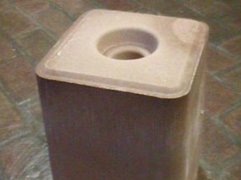Previous Page | Right click this page to print.
Feed Processing, Rumiants
Processing feeds for ruminant animals is a little different. Beef cattle we normally will recommend some grain processing, to improve the intake and efficiency of the use of these feeds. Coarse grinding is usually enough. We'll notice some improved starch digestion with heat treatments such as steam rolling or steam flaking. There is a table in your text, 11-7, that shows a number of comparisons of ground grain versus whole grain versus heat-processed grain in the performance of animals. You might want to review that, take a look at the performance of those animals under those situations. Generally, as forage increases in beef cattle feeding, processing advantage to grain will decrease. This is fairly logical in that cattle eating large amounts of forages are ruminating, regurgitating their feed, chewing their cud and in doing so process some of this grain by themselves. So, whole grains have a smaller advantage when feeding animals a lot of forages. Feedlot cattle require some grain processing.
Forage processing for beef cattle is mostly done to improve the handling, mixing, delivery of rations and not so much to improve the intake or performance of animals on those forages. If you do chop hay for cattle, there is a slightly faster forage passage rate and from that a resulting higher intake of hay. Cubed hays generally are not economical to feed to beef cattle in general and one thing to keep in mind is that generally hay cubes are too large for young beef or dairy animals to consume readily. Pelleted feeds can be used primarily to reduce waste when feeding cattle on the ground such as in wintering areas and they do allow for other supplementation, minerals, and vitamins and protein of course can be included in the pellets along with an energy supplement. This can all be in one feed, easily handled and supplied to the animals. But again, increases the costs of feeding a bit.
Supplements can also be pressed into large blocks. There is a picture on your page showing a salt block that's very typical of blocks that can be made to include protein supplements, mineral-vitamin supplements, and other needs of the cattle. The advantage of blocks are that they can regulate the intake of the animal. These blocks are made hard enough that an animal takes some time to lick or bite off corners to consume the materials. And in doing so, limits the intake to a preset amount. They can also reduce the labor of supplementation in that you can take a group of blocks out to a pastured group of animals and not have to supplement feed every day.

Dairy cattle usually will receive processed grain. It's really quite important because of their high nutrient requirements, their high daily intake of dry matter. In dairy cattle, we must balance the rapid digestibility of grains, starch, energy from grains with the acetate that's produced in the rumen. Acetate is very important in milk fat production for dairy cattle and when we provide a grain product that's readily fermentable, breaks down quickly, produces a lot of acid in the rumen, we can have problems with the acetate-propionate ratio and in so we'll get a reduced milk fat production.
Coarse-grinding, dry rolling are usually adequate for total mix ration feeding. Many dairies will have this processing on farm and not be obligated to buy processed grains. Many dairies provide texturized feeds to their cattle. Texturized feeds are those where we have a mix of pellets and rolled or flaked grains. Theses types of grains mixes are best when feeding grain separately from the forage mix, as in a milking parlor or other situation where there's no forage provided. In dairy, we'll often process the forage to some degree, again, for mixing and handling convenience in a TMR. Table 11-9 in your book summarizes some of the dairy feeding trials to show the advantages of processing grains and forages.
Finally, sheep and goats require limited processing in most cases. Fast growing lambs may benefit from some of the supplement processing. But in most cases forage and grain processing is not required. As with beef cattle, pellets can limit ground feeding waste when supplementing ewes on pasture and can slightly increase forage intake when fed in a feed lot situation. Dairy goats normally would be fed feeds that are common to dairy cattle, texturized grain and slightly chopped forages.
Previous Page | Right click this page to print.